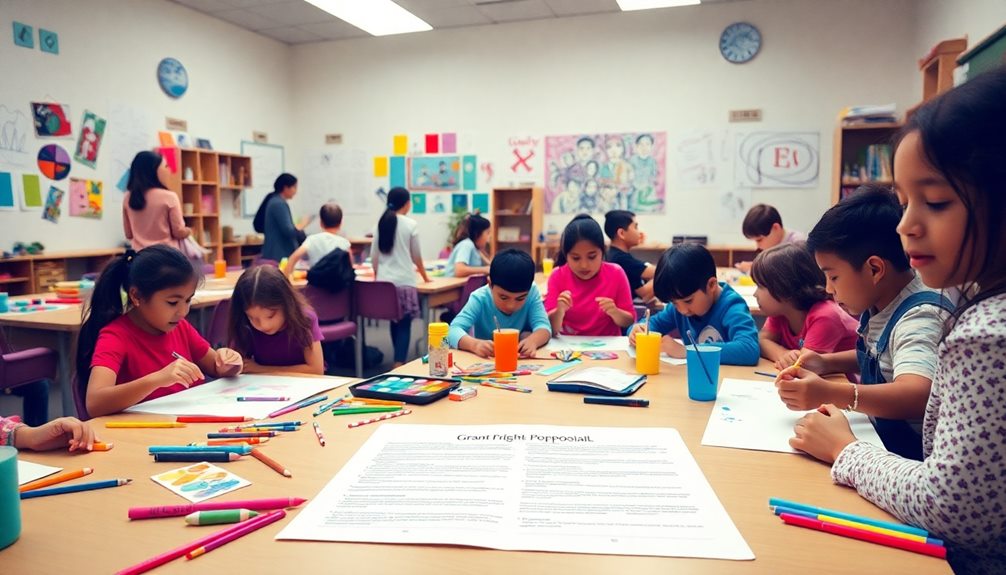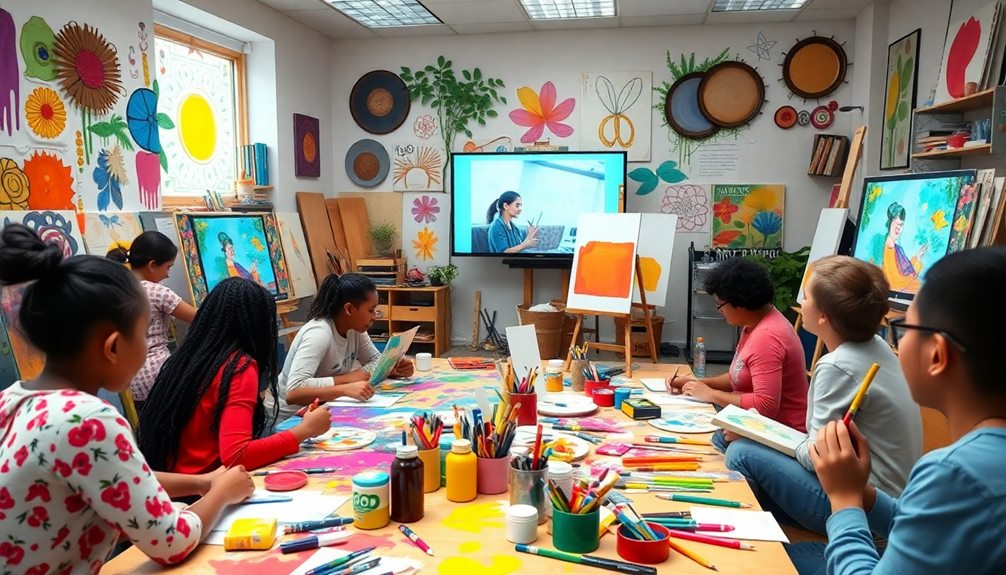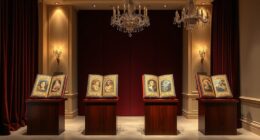Building an art education portfolio helps you document your creative journey and track your artistic growth. Start with sturdy materials like 18 x 24 Manila paper and invest in a quality binder for a professional look. Choose artwork that showcases your skills, using various media to highlight your versatility. Don't forget to organize your work logically with a clear Table of Contents. Incorporate personal touches, like artist statements and decoration techniques, to make your portfolio uniquely yours. If you're curious about more ways to enhance your portfolio, there's plenty more helpful information ahead.
Key Takeaways
- Start with a sturdy base using 18 x 24 Manila or tag board paper to secure and present artwork effectively.
- Personalize your portfolio with black sharpie markers and Crayola Construction paper crayons for vibrant designs and ownership.
- Organize artwork in a cohesive layout with a Table of Contents for easy navigation and clear presentation.
- Include a variety of media and techniques to showcase versatility and artistic growth throughout the year.
- Utilize online platforms like Behance or Dribbble to enhance visibility and network with potential employers in the art field.
Importance of Art Education Portfolios
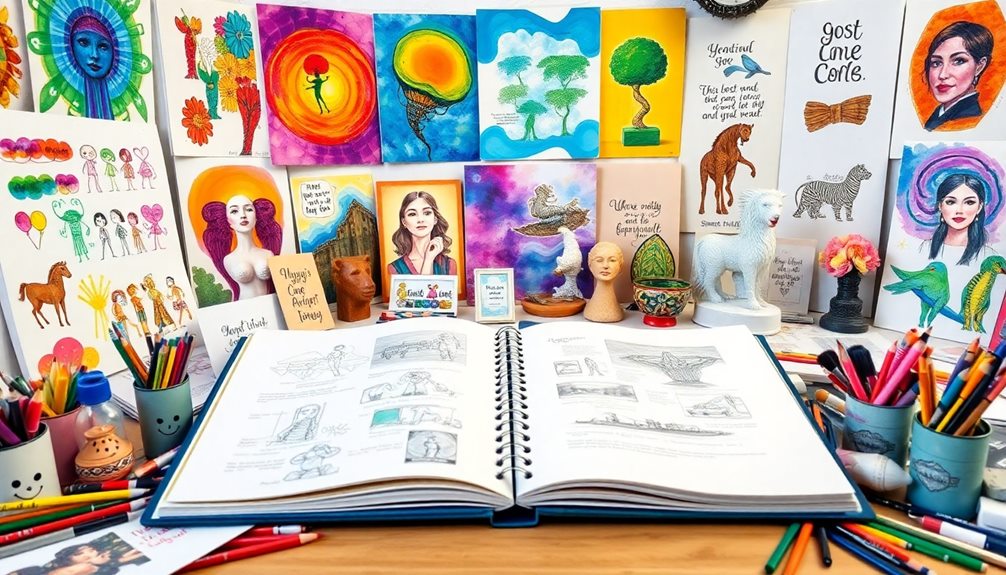
Art education portfolios are crucial tools that serve multiple purposes in a student's artistic journey. They facilitate the safe transport and storage of your student artwork, ensuring that your creations are preserved for future reference and discussion.
By maintaining a portfolio, you create a tangible record of your artistic growth over the school year, allowing you to see how much you've developed. These portfolios also encourage you to take ownership of your work, fostering a sense of responsibility for your artistic creations.
As you curate your portfolio, you celebrate your individual improvement and progress, reinforcing the significance of your artwork within an educational context. This process not only highlights your achievements but also motivates you to push your creative boundaries.
Moreover, art education portfolios provide an opportunity for personalization. You can express your identity and creativity through the design and decoration of your portfolio, making it uniquely yours.
This aspect helps you connect more deeply with your artistic journey, enhancing your overall experience. To summarize, art education portfolios are crucial for documenting your growth, fostering ownership, and allowing for personal expression in your artistic endeavors.
Essential Materials for Your Portfolio

To create a standout art education portfolio, you'll need some essential materials that guarantee quality and organization.
Think about using high-quality paper and a reliable stapler to keep everything neat and secure.
Don't forget to add your personal touch with vibrant markers and crayons to make your portfolio truly reflect your artistic style!
Must-Have Supplies
When it comes to assembling your art education portfolio, gathering the right supplies is essential for showcasing your work effectively. To meet art portfolio requirements, start with 18 x 24 Manila or tag board paper as a sturdy base. This size allows you to display your original artwork without compromising visibility.
You'll also need a stapler to secure the sides of your portfolio, ensuring that all your pieces are safely stored and easy to transport for portfolio shows.
For a polished finish, use black sharpie markers or washable markers to trace your name and any designs on the cover. This adds a professional touch that reflects your artistic skills.
To enhance the visual appeal, Crayola Construction paper crayons provide vibrant coloring options for customization.
Don't forget to include drawing guides; these can inspire your creative designs and help you exhibit your technical skills.
Personalization Options
Personalizing your portfolio is a crucial step in showcasing your unique artistic identity. To create a standout portfolio, start with 18 x 24 Manila or tag board paper as your base. This size provides ample space for both your artwork and personalized touches. Use black sharpie markers or washable markers to trace your name and add decorative elements, enhancing visual appeal.
Consider using Crayola Construction paper crayons to inject vibrant colors into your design. Incorporating drawing prompts or free drawing techniques will encourage you to customize your portfolio, allowing for personal expression. You can also include drawing guides that not only assist in decorating but promote your self-teaching and artistic growth throughout your journey as an art student.
Here's a quick reference table to help you visualize your personalization options:
| Material | Purpose |
|---|---|
| Manila or tag board paper | Base for artwork |
| Black sharpie/washable markers | Tracing names and decorations |
| Crayola crayons | Adding color and creativity |
| Drawing prompts | Fostering personal expression |
Organization Tips
Organizing your art education portfolio is essential for making a strong impression on viewers and potential employers. Start by investing in a quality binder or portfolio book to guarantee a polished and professional presentation. Use thick paper and page protectors to safeguard your artwork while creating a durable, organized appearance that's visually appealing.
A cohesive theme throughout your portfolio enhances navigation and leaves a lasting impact. Consistent formatting and creative elements provide visual unity, making your work more interesting.
Don't forget to include a Table of Contents as the first page. This logical organization helps viewers easily access different sections of your portfolio using clear headings.
Incorporate key documents such as a polished resume and standout lesson plans alongside examples of student art. These elements effectively showcase your teaching experience and artistic abilities, allowing you to present a well-rounded view of your skills.
Steps for Creating Your Portfolio

Creating your art education portfolio starts with selecting artwork that truly represents your skills and growth.
Next, you'll want to organize the layout for a clear presentation that grabs attention.
Selecting Artwork Pieces
Selecting artwork pieces for your portfolio is an important step that can greatly affect your application. Begin by reviewing the specific criteria set by the art schools you're applying to. This will guide you in selecting artwork pieces that meet their expectations.
Aim for a successful portfolio by showcasing a variety of media, techniques, and subject matter. This illustrates your versatility as an artist.
Prioritize recent works that highlight your current skills and your artistic evolution. Including pieces that showcase your observational drawing skill is vital, as it reflects your foundational abilities.
Don't forget to add process documentation, like sketches or drafts, alongside your final pieces. This not only depicts your creative development but also showcases your conceptual thinking.
As you curate your selection, avoid overwhelming the viewer. Aim for a coherent narrative or theme that connects your chosen pieces. This thoughtful approach can enhance the overall impact of your art portfolios while adhering to any submission limits.
Organizing Portfolio Layout
After curating your selection of artwork, the next step involves laying out your portfolio effectively. Your portfolio is a collection of your best work, so start with a Table of Contents. This makes navigation easy and should match the overall cohesive theme of your portfolio for visual coherence.
When organizing artwork, group similar projects together. This logical order creates a flowing layout that enhances the viewer's experience. Use high-quality images to showcase each piece, and guarantee all documentation is clear.
Maintaining a consistent formatting style throughout your portfolio is essential; it helps to unify your presentation. Incorporate a cohesive theme across all pages. Use creative elements like personal artwork for unique headers while keeping fonts and colors uniform.
This approach not only makes your portfolio visually appealing but also reflects your artistic voice.
Presentation and Style
When it comes to presenting your art education portfolio, investing in a quality binder or portfolio book is essential for making a strong impression. Use thick paper and page protectors to guarantee a polished and professional presentation.
Your portfolio should maintain a cohesive theme throughout; stick to consistent formatting, fonts, and creative elements that reflect your unique artistic style. Consider exploring mood board creation as a way to visualize your artistic journey and style.
Start with a Table of Contents as the first page to enhance organization and guide viewers through your work. Use clear headings for each section to facilitate easy navigation.
Consider including a brief teaching philosophy that summarizes your beliefs about the importance of art education, as this can prepare you for common interview questions.
Highlight key documents within your portfolio, such as a polished resume and standout lesson plans. Make sure to label student art examples clearly, guaranteeing clarity and professionalism.
Techniques for Portfolio Decoration

Decorating your art education portfolio can be an exciting way to showcase your personality and creativity. A well-decorated portfolio is always a great first impression, especially for your art school application. Start by utilizing vibrant Crayola Construction paper and crayons to enhance your drawings, adding a personal touch. Make sure to use bubble letters for your name and the year of your artwork to foster ownership and pride in your work.
To achieve a neat and polished look, trace your pencil lines with black sharpie markers or washable markers. This technique not only elevates your design but also highlights the materials used in your artistic process. Additionally, consider incorporating drawing prompts or engaging in free drawing activities as you decorate. This will inspire creativity and self-expression, making the decoration process more enjoyable.
While you're working on your portfolio, encourage the passing back of artwork among classmates. This creates an engaging environment that celebrates everyone's artistic journey.
Benefits of a Well-Organized Portfolio

A well-organized portfolio acts as a powerful tool in showcasing your artistic journey and growth. It highlights your creativity while demonstrating how your skills have evolved over time, which is vital for gaining admission to competitive art programs. Incorporating elements that reflect your understanding of various techniques, such as how to use essential oils for toothache relief, can set your portfolio apart.
When you maintain a cohesive theme throughout your art education portfolio, it enhances clarity and visual appeal, making it easier for evaluators to appreciate your body of work. Including a polished resume and standout lesson plans adds professionalism to your portfolio, reflecting your teaching philosophy and experience. This not only enhances your overall presentation but also aligns with professional standards that potential schools or employers expect.
High-quality images and clear documentation of your artworks further guarantee that your portfolio meets these standards, making a strong impression. Additionally, a well-structured portfolio, complete with a Table of Contents, allows for logical organization and quick access to various sections. This is vital for reviewers who may have limited time to assess submissions.
Ultimately, a well-organized portfolio not only showcases your artistic abilities but also communicates your dedication to your craft and readiness for the next step in your art education journey.
Online Platforms for Portfolios
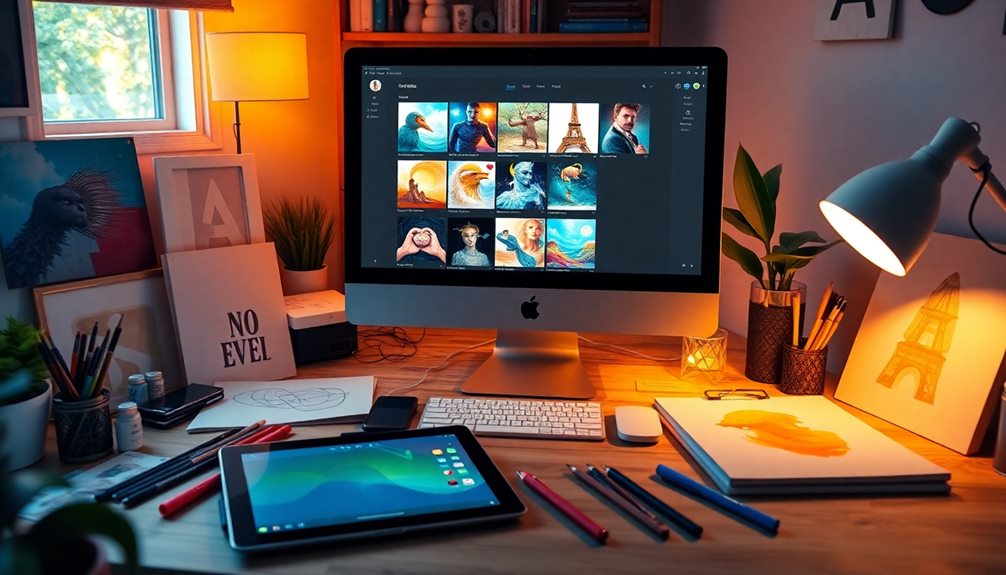
Building your art education portfolio online has never been easier, thanks to platforms like Behance, Dribbble, and Cargo.
These online platforms are tailored for creatives like you, making it simple to showcase your art and design work to a wider audience. Each platform offers unique features that can enhance your portfolio presentation.
- Behance allows multimedia integration, letting you include images, videos, and detailed project descriptions.
- Dribbble fosters a vibrant community for designers, encouraging feedback and networking opportunities with other professionals.
- Cargo provides customizable templates that reflect your unique artistic style, giving your portfolio a personal touch.
- Many platforms include job recruitment features, increasing your visibility to potential employers in the art and design fields.
Tips for Showcasing Your Work

Showcasing your artwork effectively can make a considerable difference in how potential employers and clients perceive your skills. To truly shine, include a variety of artwork in your portfolio that demonstrates your versatility across mediums like drawing, painting, photography, and digital art. This range of art highlights your different techniques and capabilities.
Additionally, incorporating wellness tips into your creative process can enhance your artistic expression and overall productivity.
When you create your portfolio, organize it with a clear Table of Contents. This helps potential employers navigate easily and understand the cohesive theme of your work. Make sure to utilize high-quality images for all pieces; well-lit and properly documented artwork presents you in the best possible light.
Incorporate artist statements or reflections for selected pieces to provide context and insight into your thought process. This not only enhances understanding but also showcases your ability to articulate your artistic journey.
Lastly, don't hesitate to seek feedback from mentors or peers. Refining your portfolio based on their suggestions can considerably improve clarity, presentation, and overall impact.
Following these tips will help you effectively showcase your work and make a lasting impression as you pursue art and design courses or job opportunities.
Frequently Asked Questions
How to Build a Portfolio for Art School?
To build a portfolio for art school, research each school's requirements, showcase diverse skills, organize it professionally, tailor it to the program's focus, and seek feedback to refine your selection. Highlight your artistic growth effectively.
What Should Be Included in an Art Portfolio?
In an art portfolio, include diverse artworks like sketches and paintings that showcase your versatility. Add artist statements for context, guarantee high-quality images, and organize everything coherently to highlight your skills and creative journey.
What Do Art Schools Look for in a Portfolio?
Did you know that 70% of art schools prioritize originality? They look for diverse artwork showcasing your creativity, technical skills, and unique style, while valuing process work that demonstrates your artistic evolution and conceptual thinking.
What Is Portfolio in Art Education?
A portfolio in art education's a curated collection showcasing your skills and creativity. It highlights your artistic development over time, featuring diverse media and documenting your process, which helps evaluate your potential for success.
Conclusion
Just like a gardener tends to their blooms, nurturing each petal with care, you too should cultivate your art education portfolio. It's a canvas that reflects your journey, growth, and passion. By selecting the right materials and showcasing your work thoughtfully, you'll create a vibrant tapestry that tells your unique story. Remember, a well-organized portfolio isn't just a collection; it's your garden of creativity, ready to flourish and inspire those who wander through its paths.




